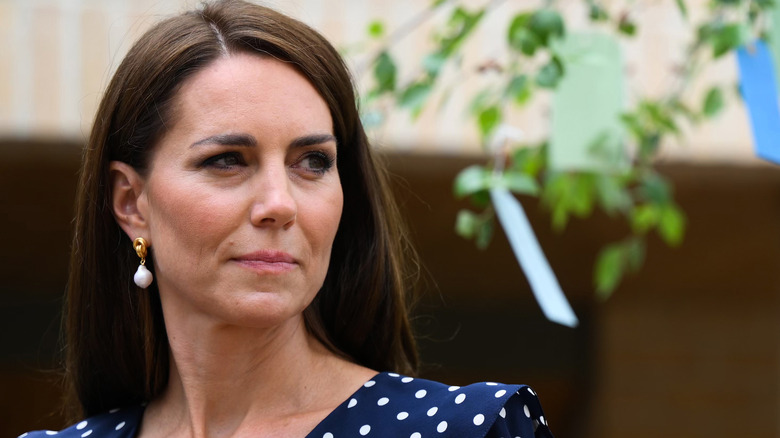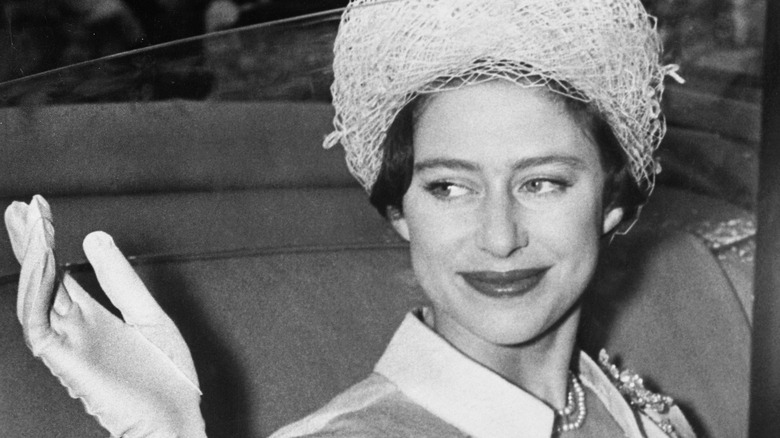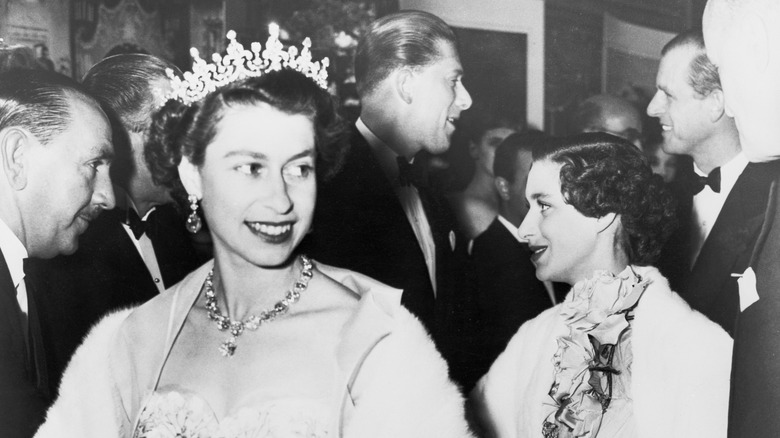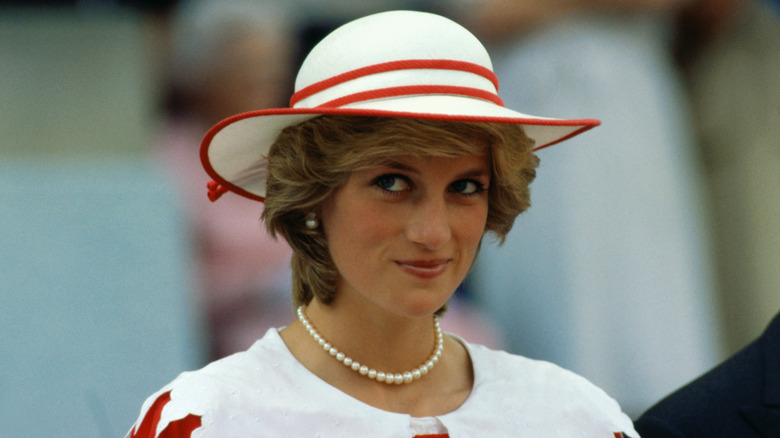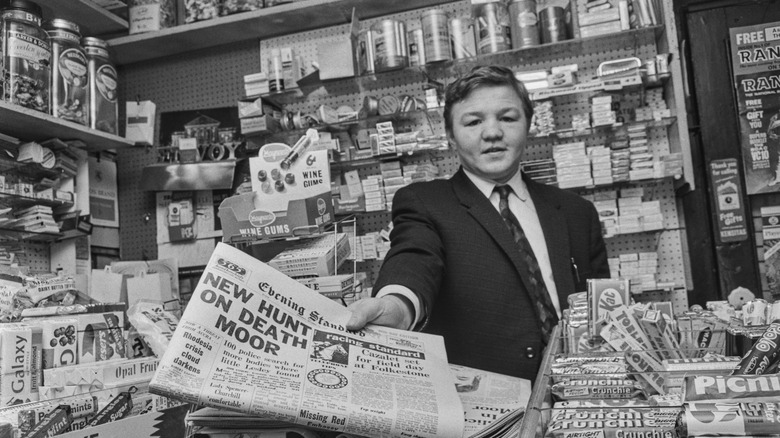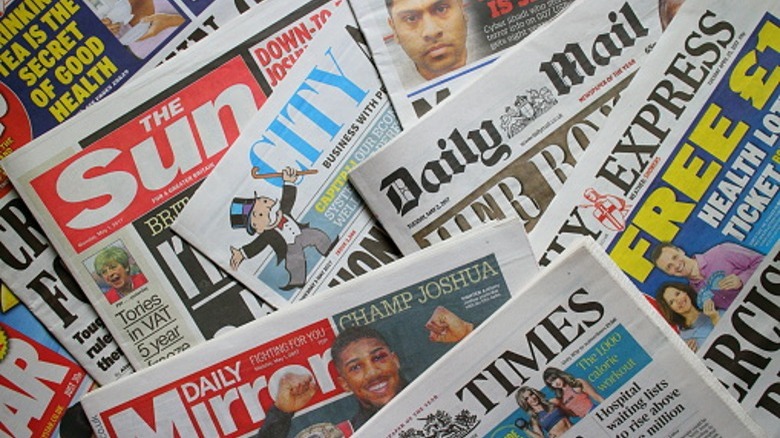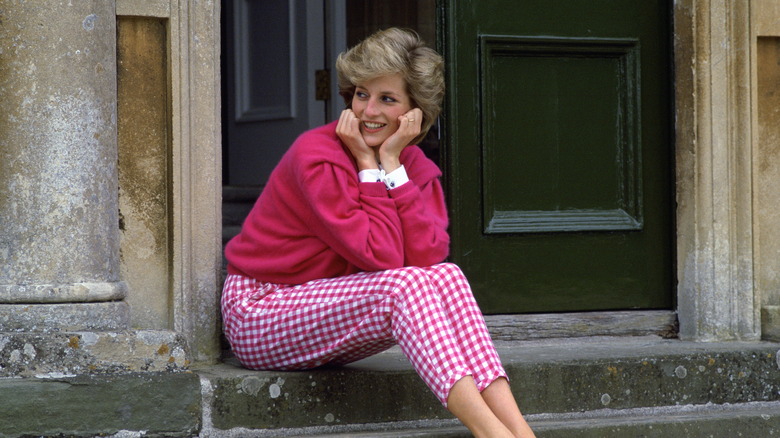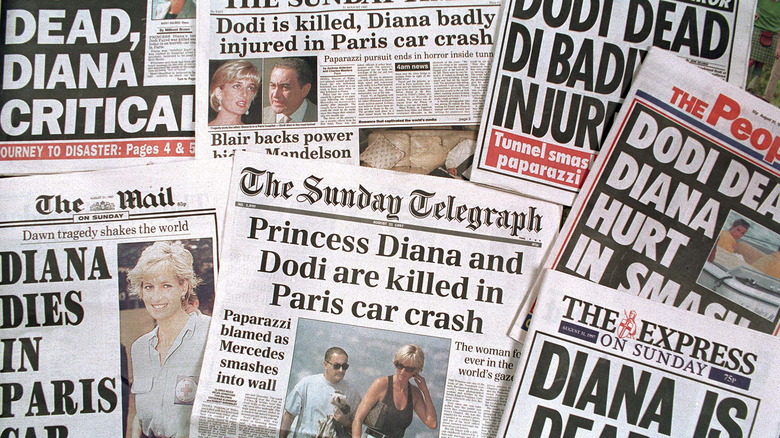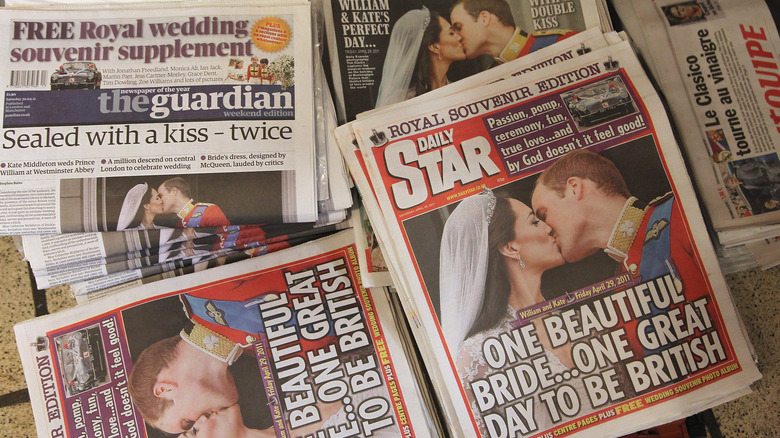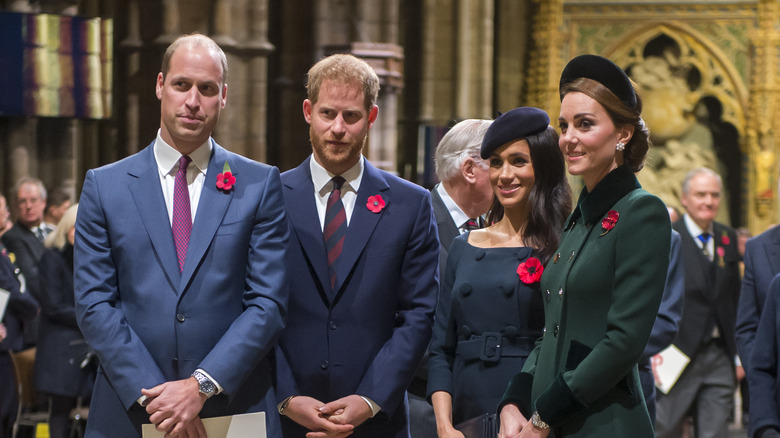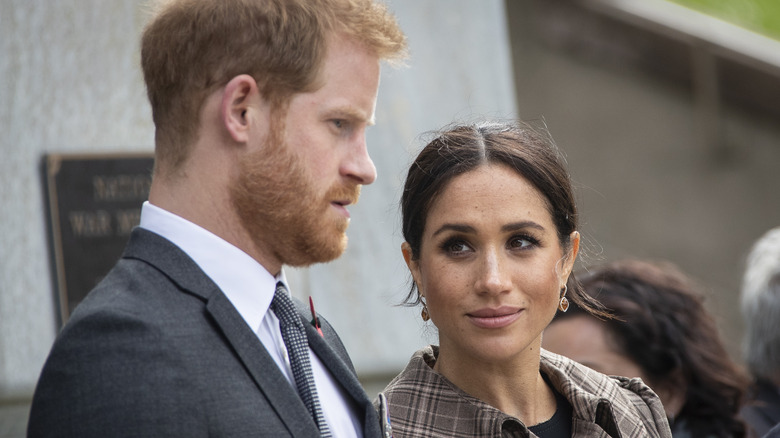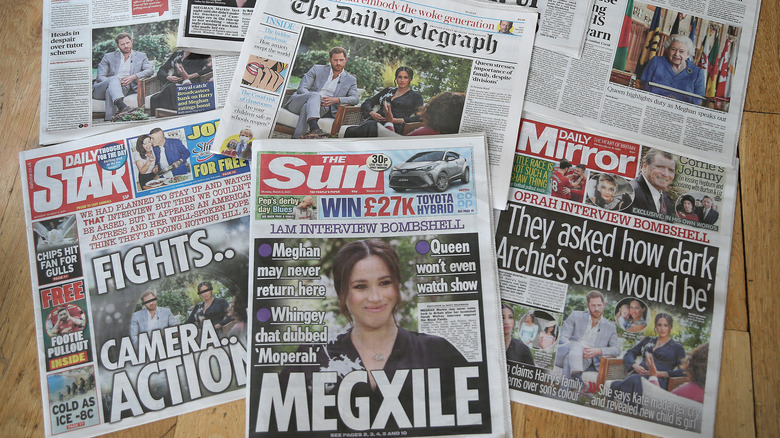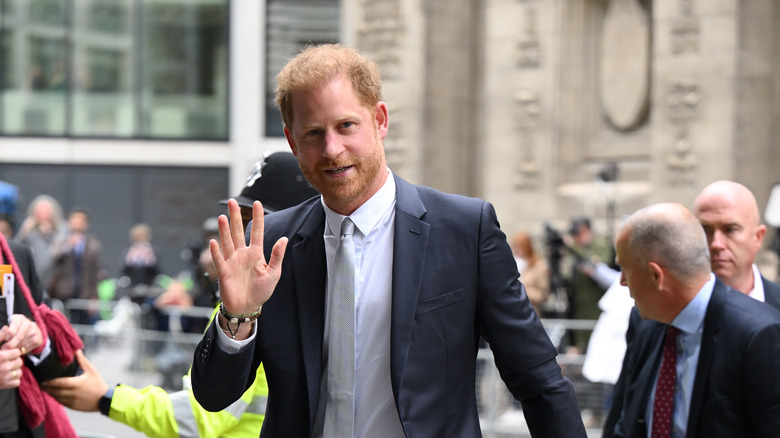Inside The Royal Rota And The Royal Family's Connection To The Tabloids
Throughout Prince Harry and Meghan Markle's high-profile exodus from royal life, the two brought up the royal rota as the main motivating factor for leaving the firm. Focusing on the heightened media scrutiny that they faced — much of it seemingly racially-charged as related to Meghan — the two took aim at the press amid their interviews, series, and books released in the time since. But what exactly is the royal rota, and how does it relate to royal life?
The royal rota is, as it operates these days, a collection of British tabloids newspapers that have direct access to the royal family. In theory, keeping the number of outlets close to the firm to a minimum helps with a number of things — security concerns, editors and reporters to answer to, being just a few — but the system has also curated a number of close relationships that are mutually beneficial. With the introduction of social media and an expansive online presence, the publications that make up the royal rota disseminate countless articles about the royal family, covering what they wear and the appearances they make to what they said during an official engagement. Where the royal rota truly sets itself apart, however, is the publications' habit of writing opinion pieces and slamming articles that take aim at whichever royal is on the chopping block that given day. The royal rota is complex, and its relationship with the firm even more so. Here's a closer look.
Princess Margaret was the first tabloid princess
Before Meghan Markle and Princess Catherine, and even before Diana Spencer, was Princess Margaret. Queen Elizabeth II's younger — and arguably more fiery — sister, Margaret is considered by many historians and royal commentators as the first tabloid princess, as the outlets took an unparalleled interest in her from day one. Notably outspoken and daring, Margaret pushed the envelope when it came to royal romances, fashion, outings, and behavior. She was without a doubt a selling point for newspapers, and before the royal rota even existed, Margaret was front and center.
Commenting on her magnetism, historian Georgie Blalock wrote for History News Network that Margaret's appeal couldn't keep up with the royal resources as related to the newspapers of the time. "Official photographs and press releases from the Buckingham Palace Press Office couldn't satisfy the demand for royal news," Blalock asserted. "To satisfy a fascinated public, newspapers reported on the good, the bad and the salacious details of Princess Margaret's life."
As such, the contentious — yet mutually beneficial — relationship between a member of the royal family and the press began to emerge, with Margaret arguably carving the path that Princess Anne, Diana, Catherine, and more would follow. "Princess Margaret might have detested the press's intrusion at times," Blalock continued, "but without their fervent coverage she would have faded into the obscurity she feared."
Queen Elizabeth II was suspicious about the press from the very start
Unlike her younger sister, Queen Elizabeth II was not a fan of the press attention her role instigated, and she certainly didn't put herself in the media line of fire if she could avoid it. Though she was on the throne for 70 years, Elizabeth had a push and pull kind of relationship with the media, maintaining her boundaries and only inviting the press in when she knew it was vital.
For example, Elizabeth identified early on that resources within the media industry would allow her to connect with the Commonwealth, of which she reigned over for the majority of her life. As radio was one of the most prominent ways to reach people back in the day, Elizabeth gave her first radio address when she was only 14 years old, talking to the children that — like her — had been evacuated from London to the countryside in order to avoid the violence that was unfolding amid World War II. From there, Elizabeth used radio in a number of capacities, later switching to broadcast television to speak directly to her subjects. In many ways, she circumvented the traditional press — and ultimately the royal rota — in order to serve her own media purpose.
Diana Spencer's era started to change the tabloid game
Before the modern day royal rota established itself, the British media and paparazzi embarked on a new era when Diana Spencer came onto the scene. Though the press agencies' relationship with the palace weren't as concrete as they are now, Diana's magnetism and the ways in which she commanded attention from the media and the public ultimately sparked change. At just 19 years old when she came onto the royal scene, media members and paparazzi were obsessed with her — she quickly became a star, and also one of the most sought-after public figures.
The Daily Mail's Nick Craven commented on Diana's early relationship with the press, asserting that the young princess knew that in order to be successful within her role, she would require a friendly press (via Vanity Fair). Not only was she winning over the public, but she was also trying to establish herself within her marriage — after all, Diana and King Charles III only met about a dozen times before they got engaged.
By the time Diana was more firmly in her role, she had her own media approach down to a science. "It is an undisputed fact that the Princess connived with the media and exploited it for her own interests, just as much as we exploited her for ours," Sir David English, the chairman of Associated Newspapers, wrote about Diana. To say that she completely changed the media game is an understatement.
The royal rota was established roughly 40 years ago
Once Diana Spencer was on the royal scene, the collective that we now refer to as the royal rota was established. Created roughly four decades ago amid the then-Princess of Wales' heightened popularity, the rota consists of a select few media outlets and newspapers that get access to all things royal before anyone else does. The idea was that by limiting the amount of physical members of the press surrounding the royals, concerns such as space limitations and security details wouldn't be as heightened. The royal rota also tends to eliminate a certain element of competition, as many reporters and outlets share information, reporting, pictures, and more.
As it stands, the royal rota is made up of The Daily Mail, The Daily Express, The Evening Standard, The Daily Mirror, The Times, The Sun, and The Telegraph. While the concept of the rota is a good idea, the realities aren't as cheery, at least according to one of its most ardent critics, Prince Harry.
"If you're part of the royal rota, you have priority over the story, over everybody else. All royal news goes through the filter of all the newspapers within the royal rota most of which, apart from The Telegraph, happen to be tabloids," Harry said during his Netflix documentary series, "Harry and Meghan." "It all comes down to control. It's like, 'This family is ours to exploit. Their trauma is our story and our narrative to control.'"
British tabloid culture is fundamentally different than its American counterpart
When Meghan Markle came onto the royal scene, she later recounted that she was shocked by the power that the members of the royal rota had on the public. While she fulfilled a very high-profile position and shared a romance with one of the world's most eligible men, Meghan was stunned by the invasive tactics that the tabloid press in Britain used in order to push a story through to print — her experience was, and is, a representation of just how different British and American press practices are.
In the United States, tabloid magazines can be found at grocery store checkout aisles and on the shelves in the airport, but few take the claims of BigFoot sightings and illicit affairs seriously. In Britain, however, the tabloids are the news — despite where the truth may lie — and American Studies professor Roger House asserts that the royals know this truth intimately.
"If there is a difference between the United States and British practices, it is in the level of aggression in pursuing (or concocting) a story," House told Reader's Digest. Countering his claim, however, was Diana Spencer's former chief of staff, Patrick Jephson, who attested that while the tactics were — and are — brutal, "most of the tabloids wrote truthful stuff."
The royal rota got its footing with Diana
Despite popular belief, the royal rota hasn't been around forever. As it was established about 40 years ago, it really got its footing as Diana Spencer rose in popularity — her relationship with the press was incredibly mutually beneficial, just as it was mutually destructive. Commenting on her early press power, Times of London editor Peter Stothard asserted that Diana quickly learned how to maneuver around the press, molding the coverage she endured to her liking. "Let it not be said that she lacked sophistication about the media, her use of it and its use of her," he told The Washington Post of the late Princess of Wales' style as the royal rota got its footing.
By the time the rota was in full swing, Diana was said to be fully obsessed by her press coverage. A friend of hers told The Spectator that the princess was "addicted to the tabloid newspapers," revealing that she would read the Daily Mail, Express, The Sun, and the Daily Mirror while eating her breakfast every morning. She would meticulously scan the papers to see how she had fared, before diving into more expansive coverage on her role as a working royal. Yet another acquaintance revealed that Diana was once at a party and kept looking at the tabloids sitting on the counter. When asked if she would like to see them, Diana said yes, before commenting, "Not a bad day for me."
British media seemingly changed its tactics after Diana's death
Just as the royal rota got its footing with Diana Spencer, it was dealt its most crushing blow amid her death. After she was chased down a tunnel in Paris, France, in August 1997 by a group of aggressive paparazzi members, Diana was fatally injured, dying at the hospital just a few hours after the initial car crash. As a result, attitudes towards the British press and the aggressive tactics used to capture moments of the princess got incredibly icey, and one Gallup poll taken shortly after her death dealt a huge punch to the tabloids.
A whopping 43% of people polled asserted that the photographers on the night in question were "extremely" responsible for Diana's death. Another 33% thought that the driver, Henri Paul — who also died in the crash — was similarly responsible. As time went on and the British tabloids contended with Diana's death, the public turned their backs on the media in general. Both The Mirror and The Sun saw their worst circulation rates in decades, and The Daily Mail went as far as promising to never use a paparazzi-sourced photo again. Such a pledge has since been ignored, but the publication's chairman, Viscount Rothermere, was besotted at the time.
"I am, and always have been, an admirer of Diana, Princess of Wales, and nagged my editors to protect her so far as they could against powerful enemies," he said after her tragic death.
The royal rota got its brutal footing once again with Princess Catherine and Meghan Markle
After Diana Spencer's horrific death in 1997, the royal rota focused much of its reporting efforts on her sons, Prince William and Prince Harry, as well as King Charles III's then-open relationship with Camilla, Queen Consort. However, things really began to rev up again when William and Harry started dating, with Princess Catherine and Meghan Markle — as well as Harry's other high-profile girlfriends — receiving a huge amount of scrutiny at the hands of the press.
Catherine, despite her put together disposition, was given nicknames and followed endlessly during her early days of dating William. Coining the term "Waity Katie," the tabloids took aim at just how long William and Catherine dated before he finally popped the question. Harry, meanwhile, faced extreme scrutiny while he dated as a young man, particularly when it came to ex-girlfriend Chelsy Davy. The two even split due to the lack of privacy they faced throughout their relationship.
Of course, royal watchers have witnessed within the last decade just how tireless the British tabloids have been when it comes to Meghan. From racially-motivated headlines taking aim at her heritage and career to easily identifiable preferences, Meghan faced a particularly brutal royal rota, coupled with the palace allegedly not going to any lengths to correct false reporting on Meghan and Harry's behalf.
Current press offices have been accused of working with the royal rota to plant stories
Aspects of the royal rota that have received scrutiny over the years are the system's close — and often very complex — relationships shared with the multitude of royal press offices. Despite the royals being one family, each couple — i.e. King Charles III and Camilla, Queen Consort, Prince William and Princess Catherine, etc. — all have different press offices. As Prince Harry and Meghan Markle have spoken out more and more about their time within the royal family, Harry went as far as claiming that royal press offices essentially work against one another, often planting stories and buddying up with the royal rota to secure more favorable coverage for their specific royal couple.
"I have 30 years experience of looking behind the curtain and seeing how this system works and how it runs. Just constant briefings about other members of the family, about favors, inviting the press in. It's a dirty game," Harry said as part of his Netflix documentary. "There's leaking, but there's also planting of stories. So if the [communications] team wants to be able to remove a negative story about their principal, they will trade and give you something about someone else's principal."
Later claiming that he and William promised one another that they would never allow their press offices to conduct themselves in such a way, Harry revealed that his brother did not hold up his end of the deal.
According to some royals, certain stories are squashed within the rota over others
As part of this trading favors the sort of dynamic that individual royal press offices have with the royal rota, Prince Harry further asserted that as the relationships stand today, the palace will squash certain stories that they don't want to see play out in the press over others. Harry and Meghan Markle used the story of Meghan allegedly making Princess Catherine cry in the lead up to the 2018 royal wedding. Meghan finally set the record straight on her own accord that it was the other way around, but the couple made it clear that the palace allegedly had no interest in correcting the narrative at the moment.
"Not only was I not being protected, but they were willing to lie to protect other members of the family," Meghan said while discussing the royal rota tactics and how the palace interacts with the tabloids. "They weren't willing to tell the truth to protect me and my husband. ... They knew it wasn't true. And I thought, 'Well, if they're not going to kill things like that, then what are we going to do?'"
Amid Harry and Meghan's estimations, some royal watchers pointed to the palace's alleged tactics used to squash any story regarding William's rumored affair, as a tweet from writer Giles Coren – which seemingly confirmed the extramarital acts on William's part — was promptly removed from social media.
Prince Harry made it clear that the royal rota was his public enemy No. 1
While Prince Harry certainly had his fair share of opinions regarding the royal family and the system in which it operates, he made it clear through "Harry & Meghan" as well as in his book, "Spare," that his real enemy amid his schism from the palace was — and is — the royal rota. When asked about the tabloid press on-camera, Harry made it painfully obvious that the hounding tactics used by the paparazzi made his life a living hell — his speaking out, as he attested, was for a far bigger reason than simply airing his grievances.
"This has always been so much bigger than us. We know the full truth. The institution knows the full truth and the media knows the full truth because they've been in on it," Harry said during the Netflix documentary series.
"Harry & Meghan" was certainly expository, and while Harry went after the press more than anything, the palace's response to the series was also very telling. Buckingham Palace did not issue any kind of public statement in the aftermath, and a representative went as far as saying that Netflix did not give the royals an opportunity to comment on the nature of the series. However, this claim was later debunked when the palace later admitted that emails had been sent on behalf of production, but were ignored due to palace protocol.
Harry has gone so far as to take members of the rota to court
In the latest development between the royal family and the royal rota as of publication, Prince Harry has really put his money where his mouth is. Traveling to London as a witness in June 2023, Harry took the stand and testified against Mirror Group Newspapers as part of a 100-person complaint, alleging that his phone was hacked for about 15 years by tabloid members.
"I believe phone hacking was on an industrial scale across at least three of the papers at the time and that is beyond doubt," Harry said while on the stand (via CNBC), before turning his attention to a potential outcome (which won't be seen for some time as of publication). "To have a decision against me and any other people that come behind me with their claims, given that Mirror Group have accepted hacking ... I would feel some injustice," he said.
Meanwhile, close royal watchers have picked up on brewing tension between the press offices of King Charles III and Camilla, Queen Consort, and Prince William and Princess Catherine's team. Catherine, who is one of the most approved members of the royal family, has now topped Charles and Camilla's own press coverage on a number of occasions, often taking up the front page of the tabloids and pushing the king and queen consort to the side.

